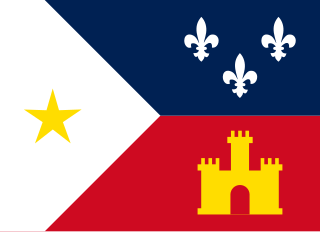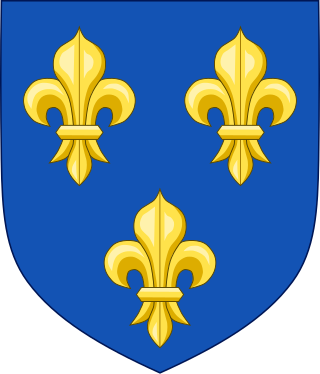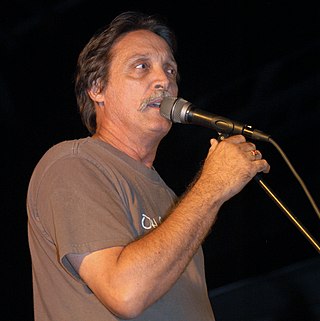
The Acadians are an ethnic group descended from the French who settled in the New France colony of Acadia during the 17th and 18th centuries. Most Acadians live in the Northern American region of Acadia, as it is the region where the descendants of a few Acadians who escaped the Expulsion of the Acadians re-settled. Most Acadians in Canada continue to live in majority French-speaking communities, notably those in New Brunswick where Acadians and Francophones are granted autonomy in areas such as education and health.

The Cajuns, also known as Louisiana Acadians, are a Louisiana French ethnicity mainly found in the U.S. state of Louisiana and surrounding Gulf Coast states.

The national flag of France is a tricolour featuring three vertical bands coloured blue, white, and red. It is known to English speakers as the Tricolour, although the flag of Ireland and others are also so known. The design was adopted after the French Revolution, where the revolutionaries were influenced by the horizontally striped red-white-blue flag of the Netherlands. While not the first tricolour, it became one of the most influential flags in history. The tricolour scheme was later adopted by many other nations in Europe and elsewhere, and, according to the Encyclopædia Britannica has historically stood "in symbolic opposition to the autocratic and clericalist royal standards of the past".

The fleur-de-lis, also spelled fleur-de-lys, is a common heraldic charge in the shape of a lily. Most notably, the fleur-de-lis is depicted on the traditional coat of arms of France that was used from the High Middle Ages until the French Revolution in 1792, and then again in brief periods in the 19th century. This design still represents France and the House of Bourbon in the form of marshalling in the arms of Spain, Quebec and Canada, for example.

Evangeline Parish is a parish located in the U.S. state of Louisiana. As of the 2020 census, the population was 32,350. The parish seat is Ville Platte.

Lafayette is the most populous city in and parish seat of Lafayette Parish in the U.S. state of Louisiana, located along the Vermilion River. It is Louisiana's fourth-most populous city with a 2020 census population of 121,374; the consolidated city-parish's population was 241,753 in 2020. The Lafayette metropolitan area was Louisiana's third largest metropolitan statistical area with a population of 478,384 at the 2020 census. The Acadiana region containing Lafayette is the largest population and economic corridor between Houston, Texas and New Orleans.

St. Martinville is a city in and the parish seat of St. Martin Parish, Louisiana, United States. It lies on Bayou Teche, 13 miles (21 km) south of Breaux Bridge, 16 miles (26 km) southeast of Lafayette, and 9 miles (14 km) north of New Iberia. The population was 6,114 at the 2010 U.S. census, and 5,379 at the 2020 United States census. It is part of the Lafayette metropolitan statistical area.

Acadiana, also known as the Cajun Country, is the official name given to the French Louisiana region that has historically contained much of the state's Francophone population.

The University of Louisiana at Lafayette is a public research university in Lafayette, Louisiana. It has the largest enrollment within the nine-campus University of Louisiana System and the second-largest enrollment in Louisiana, behind only Louisiana State University. It is classified among "R1: Doctoral Universities – Very high research activity".

The Florida Parishes, on the east side of the Mississippi River—an area also known as the Northshore or Northlake region—are eight parishes in the southeastern portion of the U.S. state of Louisiana.

The flag of Acadia is a symbolic flag representing the Acadian community of Canada. It was adopted on 15 August 1884, at the Second Acadian National Convention held in Miscouche, Prince Edward Island, by nearly 5,000 Acadian delegates from across the Maritimes. It was designed by Father Marcel-Francois Richard, a priest from Saint-Louis-de-Kent, New Brunswick. Richard's flag was a French tricolour, with a star in papal colours in the blue segment, representing devotion to the Virgin Mary – and successfully proposed that it become the Acadian national flag. At that conference Richard, using military metaphors stated "At the great 1881 convention held in Memramcook, we joined together in an orderly army set for battle, not to wage war on our brothers who share our religion, but to defend ourselves against any threat made to our nationhood." He continued in stating that this army needed a banner, "a national flag". The Musée Acadien at the Université de Moncton has the original flag presented by Father William to the 1884 Convention. It was sewn by Marie Babineau.. Also at that second convention, some suggested La Marseillaise as the Acadian Anthem, but Richard along with Pascal Poirier were successful in declaring their choice of "Ave maris stella" as the Acadian national anthem in 1884.

Louisiana Creoles are a Louisiana French ethnic group descended from the inhabitants of colonial Louisiana before it became a part of the United States during the period of both French and Spanish rule. They share cultural ties such as the traditional use of the French, Spanish, and Creole languages and predominant practice of Catholicism. Some mistakenly think the term is a racial designation, while in fact people of European, of African, and of mixed ancestry have all been termed "Creole" since the 18th century.

Barry Jean Ancelet is a Cajun folklorist in Louisiana French and ethnomusicologist in Cajun music. He has written several books, and under his pseudonym Jean Arceneaux, including poetry and lyrics to songs.

James R. Domengeaux, known as Jimmy Domengeaux, was a lawyer from Lafayette, Louisiana, who served in the United States House of Representatives for Louisiana's 3rd congressional district from 1941 to 1949. He was a cultural activist of Cajun and Louisiana Creole descent who is best remembered for his efforts to preserve the French language in his native state.

Cajun music has its roots based in the ballads of the French-speaking Acadians of Canada, and in country music.

Southwest Louisiana (SWLA) is a five-parish area intersecting the Acadiana and Central Louisiana regions in the U.S. state of Louisiana. It is composed of the following parishes (counties): Allen, Beauregard, Calcasieu, Cameron, Jefferson Davis. As of 2020, the combined population of the five parish area was 313,951.
The Pride of Acadiana is the marching band at the University of Louisiana. The band plays pregame and halftime shows for all home games of the Louisiana Ragin' Cajuns football team.

The municipal flag of New Orleans is the representative banner of the U.S. city of New Orleans, Louisiana. The flag has a large white field that contains three gold fleurs-de-lis and is bordered on the top by a red stripe and from below by a blue stripe. The presence of the fleur-de-lis, a stylized depiction of a flower and a traditional French symbol demonstrates the city's French heritage and strong ties to France, while the presence of the design being a Spanish fess demonstrates the city's Spanish heritage and strong ties to Spain.
Attakapas Parish, a former parish (county) in southern Louisiana, was one of the twelve parishes in the Territory of Orleans, newly defined by the United States federal government following its Louisiana Purchase in 1803. At its core was the Poste des Attakapas trading post, which developed as the current city of St. Martinville.

Louisiana French is an umbrella term for the dialects and varieties of the French language spoken traditionally by French Louisianians in colonial Lower Louisiana. As of today Louisiana French is primarily used in the state of Louisiana, specifically in its southern parishes.
















